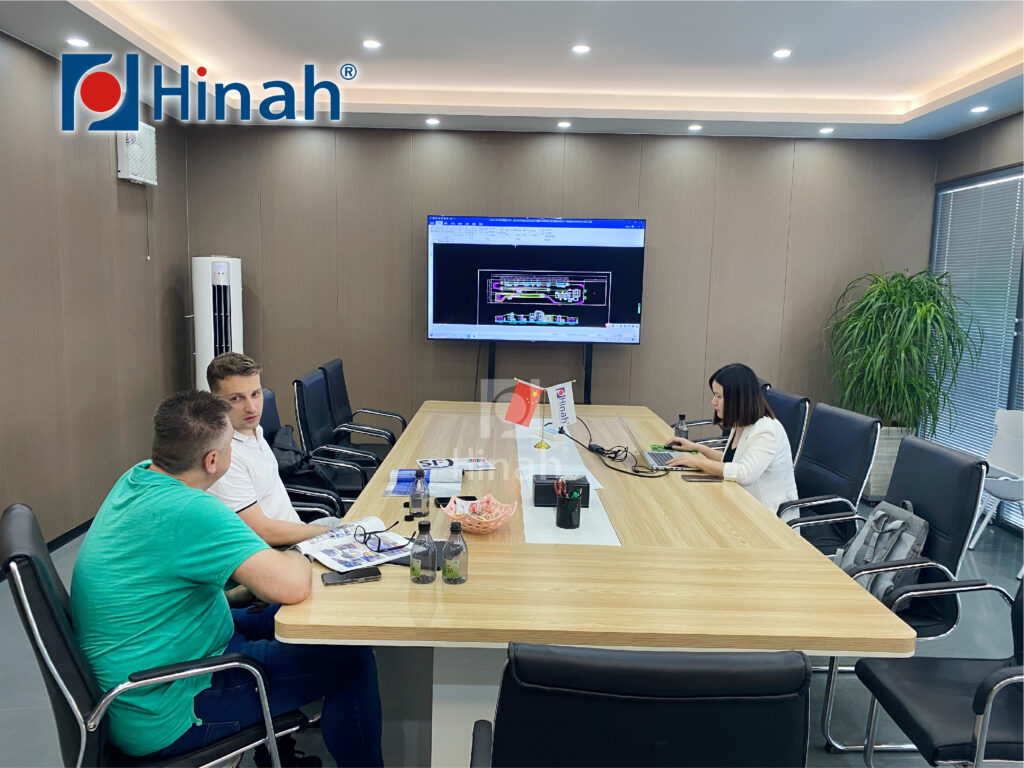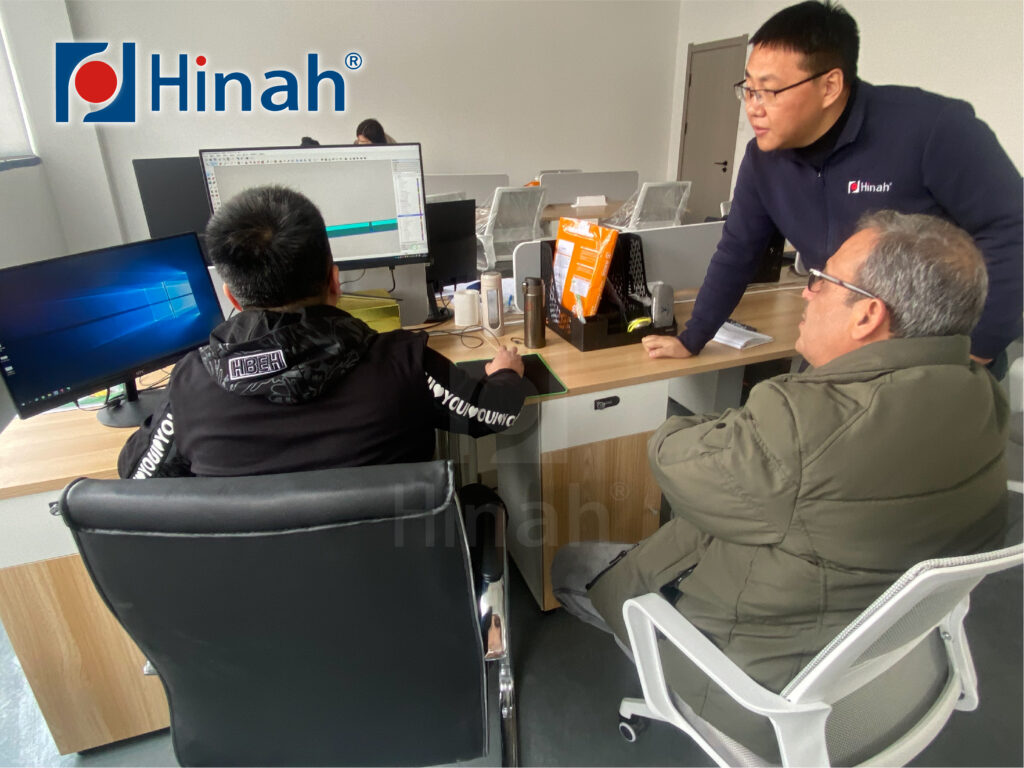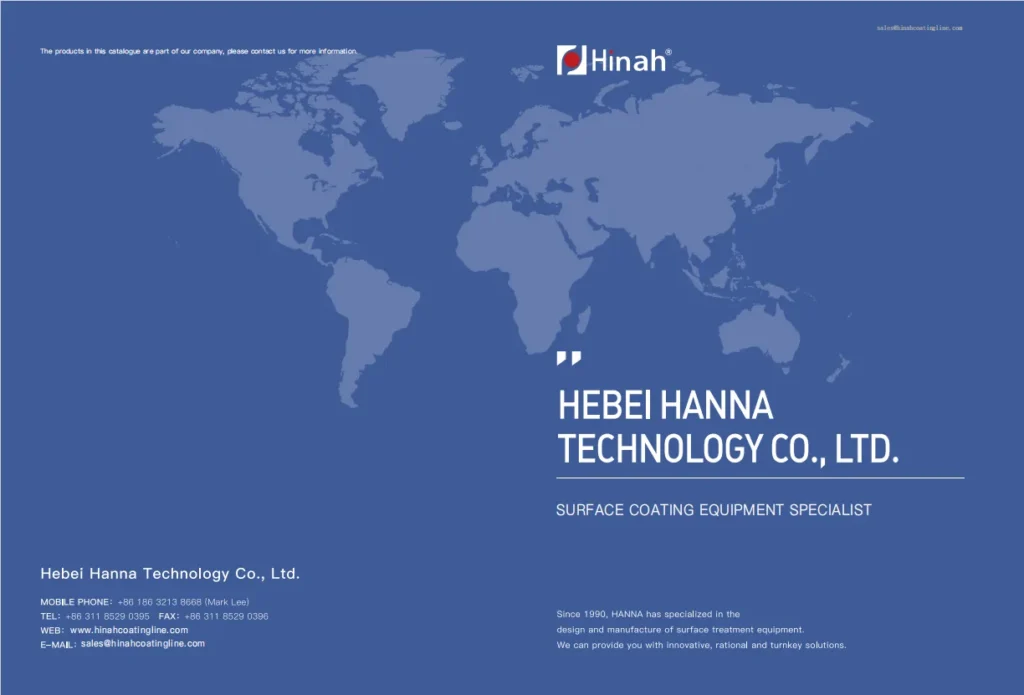order process
Precision Engineered for Peak Performance
With over 30 years of experience in industrial finishing systems, we would be the one to choose when you need to work with a partner who can supply industrial finishing systems for powder coating, liquid painting and e-coating.
All of HANNA Technology’s coating solutions are customized to meet the needs of our customers. To ensure that customers get exactly what they need, our technical team will help them work through all the details right up to their goal. From initial design to delivery, installation, commissioning, and training, HANNA would take care of it all.
1. Project Commencement
2. Material Procurement
3. Incoming Material Inspection
4. Production Execution
5. Assembly Functional Testing
6. Pre-Shipment Final Inspection
7. Shipping Logistics Management
8. Post-Delivery Activities
Pre-sale Details

Personalized Inquiry & Tailored Quotation
HANNA responds to all customer inquiries within 24 hours, ensuring timely and professional communication. Whether you’re asking about equipment specifications, performance, pricing, or delivery timelines, our team provides detailed and accurate answers to help you make informed decisions. You can also request our catalogs, technical parameters, and previous case references to better understand our capabilities.
Based on your production requirements and coating goals, we will offer a customized quotation along with preliminary layout drawings and solution sketches. Every proposal is designed around what you truly need — we never oversell or suggest excessive equipment. Our goal is to provide a practical and efficient solution that fits your real production scenario and budget.
Comprehensive Design Solution & Support
Once your basic needs are confirmed, HANNA’s experienced technical team will develop a comprehensive powder coating line design tailored to your specific project. This includes a detailed layout plan, process flow diagram, equipment configuration list, technical specifications, and itemized pricing.
Our design process takes into account multiple variables such as workpiece size, shape, quantity, surface quality requirements, available factory space, environmental conditions, and energy options. We prioritize safety, reliability, and energy efficiency throughout every design. After mutual discussion and adjustments, the finalized plan becomes the basis of our sales contract.
Our commitment to continuous improvement means we don’t just deliver a solution — we support its long-term performance and reliability.


HANNA Company Profile
- Thirty years of production and design experience in shot blasting.
- Equipment gets the international certification: CE, ISO14001, ISO9001, TUV, BV.
- Get a government-granted endorsement of trust. ATHI is trustworthy.
- All designs adopt 3D Design.
- OEM&ODM factory, High-quality after-sales service
- All adopt general parts, easy to buy and replace.
- Domestic certificate: AAA corporate certificate (The first AAA enterprise in Qingdao).
Loading & Shipping
Packaging and shipping are an important part of the export business, which ensures that our previous efforts are not lost. A good packaging and shipping solution is very practical and safe.
We have made proper arrangements for packing materials and methods. The use of thick cartons or wooden boxes, foam, crash pads, corner guards, and other materials can improve the safety of the cargo. Through our pre-assembled model simulation, we can make the most cost-effective choice of container type. Reasonable distribution of cargo weight and space, to avoid uneven weight distribution, while reducing the difficulty of unloading and picking up the goods.
Ocean transportation is a common mode of equipment transportation, especially for large equipment or transportation across oceans, and it offers the advantages of efficiency, economy, and reliability. However, ocean transportation also involves some considerations and critical points to ensure the safe and smooth delivery of equipment. The following are some of the important things to consider when shipping by sea:
- Packaging and securing: Challenges faced by equipment in marine transportation include waves, wind, and bumps. Therefore, equipment must be properly packaged and secured to prevent damage or tilting during transport. Use appropriate packing materials and cushioning materials, and use solid lashing and securing equipment to ensure that the equipment can withstand the conditions of transport.
- Transportation method selection: Choosing the appropriate transportation method for the equipment is critical. Depending on factors such as the size, weight, and destination of the equipment, a container ship, bulk carrier or dedicated vessel can be selected. Proper choice of transportation mode can minimize transportation costs and ensure the safety of the equipment.
- Contract of carriage and insurance: it is very important to ensure that a detailed contract of carriage is signed with the carrier before carrying out sea transportation. The contract should agree on the matters of liability, insurance responsibility, compensation, and claims. At the same time, the purchase of proper cargo transportation insurance can provide necessary protection in case of accidents.
- Route and port selection: Choosing the right route and port is the key to ensuring the timely arrival of equipment at the destination. Consider factors such as transit time, traffic conditions, port facilities, and service quality to choose the best route and port to minimize delays and uncertainty.
- Safety and compliance: It is important to ensure that equipment meets relevant safety standards and regulatory requirements. In international maritime transportation, International Maritime Organization (IMO) regulations and conventions must be followed. Equipment must be inspected and certified and have the necessary safety equipment and markings.
- Loading and unloading operations: Equipment is easily damaged during loading and unloading, so special attention should be paid to the safety of loading and unloading operations. Reasonable arrangements for lifting equipment, use of professional loading and unloading teams, and appropriate protective measures, such as the use of lifting devices and protective materials, to prevent damage to equipment in the loading and unloading process.
NEED HELP NOW?
Our coating line experts guarantee response within 4 hours and customized solutions within 24 hours. With 30+ years of industry-specific experience, we’ll diagnose your line issues and deliver fast-track improvements – guaranteed compliance with international coating standards.
Installation & Maintenance
Installing powder coating line equipment is a complex process that requires careful planning and specialized technical knowledge. The following are some general guidelines for installing powder coating line equipment:
- Create a construction plan: Before installing powder coating line equipment, it is critical to create a detailed construction plan. This plan should include consideration of equipment layout, workflow, required resources, and schedule. Ensure adequate communication and coordination of efforts with the supplier and installation team.
- Equipment layout design: Based on the space and process requirements of the plant, carry out equipment layout design. Consider the flow sequence of the painting line and rationalize the location of each part to achieve an efficient production process. Make sure there is enough spacing and access between equipment for easy operation and maintenance.
- Foundation and support structure: Powder coating line equipment needs a strong foundation and support structure to ensure stability and safety. Design and construct the foundation and support structure according to the equipment specifications and requirements provided by the supplier. Make sure the foundation and support structure meet the specifications and can withstand the weight and vibration of the equipment.
- Power and gas supply systems: Powder coating line equipment usually requires a large amount of power and gas supply. Ensure that the power and gas supply systems meet the needs of the equipment and comply with safety standards. Coordinate with suppliers and relevant departments to ensure that the equipment is properly connected to the power and gas supply to ensure proper operation.
- Piping and piping layout: Powder coating line equipment requires liquid delivery systems, including water, paint, and cleaning agents. Properly design and lay out piping and piping to ensure smooth flow of liquids and avoid leakage and pressure loss. Use appropriate pipes and connections, and conduct rigorous inspection and testing to ensure the reliability and safety of the piping system.
- Control systems and automation: Powder coating line equipment is usually equipped with control systems and automation equipment to monitor and control the production process. Install and commission the control system to ensure it matches the proper operation of the equipment, and perform the necessary programming and commissioning. Ensure that the operator is familiar with the operation and maintenance of the control system.
- Safety features and precautions: When installing the electrodeposition line equipment, ensure that the necessary safety features and precautions are installed. It is very important to ensure that the necessary safety features and precautions are installed. These include emergency stop buttons, safety gates, guardrails, warning signs, and emergency evacuation routes. Ensure that the installation meets the relevant safety standards and conduct the necessary training to raise the safety awareness of operators and staff.
- Testing and commissioning: After completing the installation of the equipment, carry out the necessary testing and commissioning work. This includes electrical system testing, piping system testing, control system testing, and functional verification of the equipment. Ensure that equipment is thoroughly checked and adjusted before operation to ensure it is working properly and performing as expected.
- Training and documentation: After the equipment is installed, conduct operator and maintenance personnel training to ensure they are familiar with the operation and routine maintenance of the equipment. Also, establish a comprehensive documentation system, including technical specifications of the equipment, installation records, operation manuals, and maintenance logs. This will help in the management and maintenance of the equipment and provide necessary reference materials.
- Monitoring and maintenance: After the installation is completed, regular monitoring and maintenance of the equipment is necessary. Regularly check the operating status of the equipment, fluid supply, electrical system, and control system to ensure that the equipment remains in good working condition and performance. Timely handling of equipment malfunctions and abnormalities and preventive maintenance are performed to extend the equipment’s service life and ensure the continuity of production.
Professional Installation Assurance
- Detailed Installation Manual Service
- Professional Installation Guidance Service
- On-Site Installation Guidance Service
- Remote Technical Support Service
- Training & Training Materials Service
- Comprehensive After-Sales Support Service
After-sales Service
01
After-sales technical support
Timely and professional technical support. This includes equipment operation guidance, troubleshooting, maintenance advice, and technical consultation. Suppliers should provide a variety of communication channels, such as telephone support, online support, and on-site support, to help customers solve problems encountered during the use of the equipment.
02
Quick response and maintenance
Respond quickly when equipment failures occur and provide timely maintenance services. Suppliers should establish a sound after-sales service system to ensure that they can dispatch maintenance personnel to the customer’s site promptly to carry out repairs. Quick response and repair will reduce production downtime and improve the customer’s productivity.
03
Equipment spare parts supply
Original spare parts supply and support. The quality and adaptability of original spare parts are more guaranteed and can ensure the normal operation and performance of the equipment. The supplier should establish a perfect spare parts management system to ensure the timely and reliable supply of spare parts, and provide the spare parts list and ordering channels to the customer.
04
Regular maintenance and servicing
Regular equipment maintenance and servicing services. Regular maintenance can prevent equipment failures and problems and keep the normal operation and stable performance of the equipment. The supplier should make a maintenance plan and dispatch technicians regularly for equipment inspection, cleaning, lubrication, and adjustment to ensure the good condition and best performance of the equipment.

